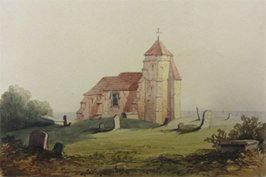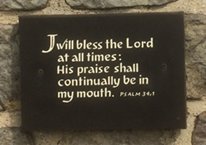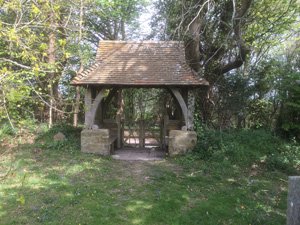
Saint Andrew’s Parish Church, Fairlight
The name Fairlight has only been in use for the last 200 years or so. Previously the village was known variously as Farleg, Farleia, Fernlega, Farleigh, Fairlyghe and Farnleigh. The origin of the name is unknown: some say it is derived from Fern Leah (meaning ‘bracken clearing’); others that it refers to the site of an ancient pharos light (or beacon), which would be lit to warn of impending invasion. Following the Norman Conquest, the village formed part the Hundred of Gestelinges (Guestling) within the Rape of Hastings, governed by Robert of Eu.
We know from the Domesday Book, completed over 900 years ago, that there was already a church in Fairlight at that time. A new stone built church was constructed, on the present site, in 1180 and probably extended over the next 100 years. By the middle of the 19th century, the 700 year old building (pictured right) was too small to meet the needs of the parish and the structure was in danger of collapse; the spire having already been removed from the top of the tower because it was unsafe.
Construction of the present church began in 1845 and it was consecrated in August the following year, by the Bishop of Chichester. It is considerably larger than the old church and legend has it that it contained a seat for every one of the 366 people living in the parish at that time.
On the north parapet, at the top of the tower is a special plaque. It was donated shortly after the Second World War by the Evangelical Sisterhood of Mary, an order of German nuns who visited England in a spirit of repentance and reconciliation. Such plaques were placed at various historic places and beauty spots, the top of St. Andrew’s Church tower being one such location.
The Belfry contains one bell, dating from the 14th century, which is still tolled regularly. In 1950 another peel of eight bells was added. These are operated by a large wooden "keyboard" which can be used to play hymn and other tunes which can be made with 8 notes in the octave. Historian Alan Buswell informs us that Ellecombe Johnston Foundry cast a new bell in January 1950. The details of this new bell are as follows: 21 1/8 diameter, Weight 2cwt 2qrs 5lbs in Ab.
On the Battery Hill frontage of the churchyard is an attractive lychgate (see right), erected in 1926 as a memorial to members of the Lucas-Shadwell family who lived lived at Fairlight Hall in the valley to the north of the church. From the Old English ‘lic’, meaning corpse, the gate reminds us of the days when motor vehicles were few and far between, Battery Hill was a quiet country lane and the gate afforded a safe and convenient entrance to the churchyard.
The graveyard contains many interesting memorials, including those to:-
*The Parents and Sister of Cecil Rhodes. Cecil Rhodes founded Rhodesia (now Zambia and Zimbabwe) and used to enjoy walking in Fairlight Glen during home visits.
*Richard D’Oyly Carte, D’Oyly Carte was a famous Victorian theatrical impresario who founded the opera company which still bears his name.
*The Earl and Countess Waldegrave. William the 8th Earl Waldegrave (a direct descendant of William the Conqueror) and his wife Sarah, and their daughters.
St. Peter’s Church Centre, Fairlight Cove
As the number of dwellings in the Cove area increased during the 1920s and 30s, so the need for a church to serve that part of the parish (and save people the long uphill trek to St Andrew’s) became established . St. Peter’s, which was dedicated in 1947, would have come into being rather sooner had it not been for the Second World War, but in an odd way the war also enabled the project to go forward.
Several vicars were instrumental in bringing the project to fruition. Firstly, Rev George Northridge, who had come to Fairlight in 1936, oversaw the acquisition of land in Broadway with funds raised by parishioners who organised fetes, bring and buy sales and all sorts of fund-raising schemes but without achieving the necessary total to enable the building to proceed. This was left to Northridge’s successor, Herbert Hinde, whose renewed appeals for donations met with a positive and generous response.
This enabled a sectional military hut which was surplus to requirements at the end of the war to be acquired, moved to the site and re-erected. It had been previously a section hut for personnel manning the anti-aircraft battery near Storm Point at the end of Hill Road. Those who recall it say that it made a lovely little church (pictured right) with seating for 80-100 people .
That is not the end of the story, however. Although the ex-Army hut fulfilled the immediate need, there was still an impetus for a proper church building. In 1968 it was discovered that the old building’s floor timbers were riddled with rot; so much so that it had to be condemned and new accommodation found quickly. The energies of the then vicar, Rev George Seamer, led to further rounds of fund-raising and the Diocese of Chichester came good, through its Sussex Churches Campaign, with an £8,000 new building. The original idea was that the new structure would be of a temporary nature which would tide the Parish over a period of some 5 years or so, whilst money was raised for a permanent building.
In the event, in December 1970, the Archdeacon of Hastings, the Venerable Guy Mayfield, performed the dedication of the new St. Peter’s Church – a plain but stylish wooden structure standing, as it does today, on the corner of Waites Lane and Broadway adjacent to the Village Hall. The Hastings Observer said: “It is a simple building, the only decoration being a gold curtain on which hangs a wooden cross behind the communion table. In one corner stands a large ornate pulpit given by St Clement’s, Halton, and at the back of the hall is a two-manual Compton electronic organ. A small vestry and rooms for making tea are located on either side of the entrance and the church is sited on a prominent corner of Waites Lane.” More recently, the church office has been moved from the vacated vicarage to the vestry in this building. It has also been redecorated, modernised and new stacking chairs added to make it a multi purpose centre for the Fairlight community.
(HSLO, Dec 18, 1970)
(We are grateful to Haydon Luke for the early history of St. Peter’s)


